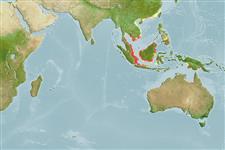Teleostei (teleosts) >
Perciformes/Scorpaenoidei (Scorpionfishes) >
Platycephalidae (Flatheads)
Etymology: Grammoplites: Greek, gramma, atos = signal, mark + Greek, hoplon = shield (Ref. 45335).
Eponymy: Dr Leslie William Knapp (1929–2017) was an ichthyologist at the Department of Vertebrate Zoology, National Museum of Natural History, Smithsonian. [...] (Ref. 128868), visit book page.
Environment: milieu / climate zone / depth range / distribution range
Ecology
Marine; demersal; non-migratory; depth range ? - 32 m (Ref. 9790). Tropical
Western Pacific: Hainan Island, China, the South China Sea, the Gulf of Thailand and Johore shoals of Malaysia.
Size / Weight / Age
Maturity: Lm ? range ? - ? cm
Max length : 30.0 cm TL male/unsexed; (Ref. 9790); common length : 25.0 cm tl male/unsexed; (Ref. 9790)
Dorsal spines (total): 9; Dorsal soft rays (total): 12; Anal spines: 0; Anal soft rays: 12. Lateral line scales frequently 53, each scale with a backward directed spine that does not extend beyond rear margin of scale. Interorbital width less than 9% of head length. Caudal fin frequently with 2 dark bands posteriorly. Dorsal fin rays IX, I,VIII, or I,VII,I, usually I,VIII.
Life cycle and mating behavior
Maturity | Reproduction | Spawning | Eggs | Fecundity | Larvae
Knapp, L.W., 1999. Platycephalidae. Flatheads. p. 2385-2421. In K.E. Carpenter and V.H. Niem (eds.) FAO species identification guide for fishery purposes. The living marine resources of the Western Central Pacific. Volume 4. Bony fishes part 2 (Mugilidae to Carangidae). FAO, Rome. (Ref. 9790)
IUCN Red List Status (Ref. 130435: Version 2024-2)
Threat to humans
Harmless
Human uses
Tools
Special reports
Download XML
Internet sources
Estimates based on models
Preferred temperature (Ref.
123201): 26 - 29.2, mean 28.8 °C (based on 1064 cells).
Phylogenetic diversity index (Ref.
82804): PD
50 = 0.6250 [Uniqueness, from 0.5 = low to 2.0 = high].
Bayesian length-weight: a=0.01000 (0.00244 - 0.04107), b=3.04 (2.81 - 3.27), in cm total length, based on all LWR estimates for this body shape (Ref.
93245).
Trophic level (Ref.
69278): 3.8 ±0.6 se; based on size and trophs of closest relatives
Resilience (Ref.
120179): Medium, minimum population doubling time 1.4 - 4.4 years (Preliminary K or Fecundity.).
Fishing Vulnerability (Ref.
59153): Low vulnerability (20 of 100).
